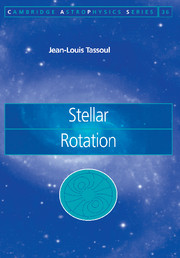3 - Rotating stars
Published online by Cambridge University Press: 15 August 2009
Summary
Introduction
Consider a single star that rotates about a fixed direction in space, with some assigned angular velocity. As we know, the star then assumes the shape of an oblate figure. However, we are at once faced with the following questions. What is the geometrical shape of the free boundary? What is the form of the surfaces upon which the physical variables (such as pressure, density, …) remain a constant? To sum up, what is the actual stratification of a rotating star, and how does it depend on the angular velocity distribution? For rotating stars, we have no a priori knowledge of this stratification, which is itself an unknown that must be derived from the basic equations of the problem. This is in sharp contrast to the case of a nonrotating star, for which a spherical stratification can be assumed ab initio.
In principle, by making use of the equations derived in Section 2.2, one should be able to calculate at every instant the angular momentum distribution and the stratification in a rotating star. Obviously, this is an impossible task at the present level of knowledge of the subject, even were the initial conditions known. Until very recently, the standard procedure was to calculate in an approximate manner an equilibrium structure that corresponds to some prescribed rotation law, ruling out those configurations that are dynamically or thermally unstable with respect to axisymmetric disturbances (see Sections 3.4.2 and 3.5).
- Type
- Chapter
- Information
- Stellar Rotation , pp. 65 - 92Publisher: Cambridge University PressPrint publication year: 2000

